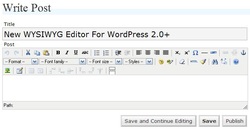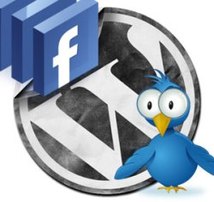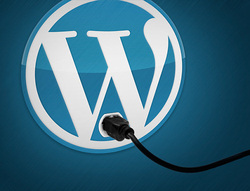
Website evolution has been interesting to say the least. They started out as file directories with links to files. As the pages themselves evolved, we started with a lot of very drab, mostly academic pages consisting of walls of text. People soon started to add colours and decoration to the site which led into the horror of gifs (the little moving images that repeat) that still makes developers cry to this day. Slowly but surely, sites evolved, adding interactivity and becoming easier to use as each day passed. Now it is common to have a fully interactive site with video and multiple feedback options, including email, various social media outlets and commenting right on the site. With so many different options and expectations for sites growing every day, your site becomes more essential and complicated as time goes on. WordPress is an invaluable tool allowing you to manage your site. Let's take a look at that now.
We'll start by taking a look at what WordPress is. Originally, WordPress was developed as a blogging platform. The emphasis was on blogging and it allowed for focused development. Since it is open source which means that anyone can use, modify and edit the code however they would like,people have taken advantage of this and developed other uses for the platform in addition to blogging. There are a ton of amazing tools (called plug-ins) that make building and managing your website easy without the need for a lot of code.

Being open source, it also means that there is no additional cost to use this platform on your website. You can download and install the software quickly and easily on to your server yourself but many hosting services have auto installers that will install WordPress with a few quick clicks and no downloads required on your part. There is premium content available for various fees that have various applications but these are always optional and never required.
Choosing a look for your site is as simple as picking a theme. There are literally thousands of themes available free of charge through your WordPress dashboard. They are easily applied to your site with a few simple clicks. Depending on the themes you are changing to/from, you may need to tweak your content slightly to fit the new design but a drastic change to your site's look is very easy. There are a few pitfalls of using free themes. The most important one is that if you download free themes from random websites, they can often be used to store malicious code or other things that can get your site flagged. The good news here is that the free themes provided by WordPress are free of issues like that. The downside here is that a lot of people use WordPress and use the free themes. You can pick up premium paid themes for reasonable amounts so that your site doesn't look like everyone else's.

The editor for the pages is known as a What You See Is What You Get (WYSIWYG) editor, meaning that what you see in the fame is what you will see on the site. This allows you to place things as you want them and WordPress takes care of the code. For making posts, the interface is very similar to MS Word. You can change your font (which are limited but this is due to the way font selection works with websites), make it bold or italic and change the size of the font. Inserting photos is a matter of uploading them through the image button and then dragging it where you want. You can also edit other options for the image in a separate menu. Whether it is making a post or a new page, the process is similar and with plenty of easy to understand options, you can make quick updates to your content easily.

Something important to mention are widgets. Widgets are commonly used to display information and bring up controls. Widgets are available in a variety of applications (including Windows) and function similarly here. You drag and drop the widgets to the areas you want them and they add functionality to your site. This could be something like buttons for social media, a list of previous blog posts or even to display recent tweets on your Twitter account. There are over 100,000 widgets available from WordPress and they do a bevy of different things. This makes it incredibly easy to add features to your website, including dynamic content.

There are a lot of other plug-ins that can add all sorts of functionality to your site. Plug-ins can let you collapse content, play media files, register users, accept donations and much more. When you want to add a function to your site, not only do these tools make it easier to do so, there is also a massive WordPress community to help you accomplish your goals. They can recommend plug-ins, give you coding options, help to troubleshoot issues and even improve your overall results. WordPress receives regular updates and is showing improvements all the time. Many plug-ins are developed to either fill a need or fix an issue with WordPress which they often fix with new releases. They also like to integrate the more commonly used plug-ins to improve the product and allowing you to use less plug-ins.
With more information being put on to sites all the time and the need for better functionality and more dynamic content, a CMS makes sense. WordPress is free, supported by an incredible community and very powerful. With a WYSIWYG editor, drag and drop widgets and a familiar, Office like environment for posts, the system is intuitive, easy to use and requires next to no knowledge of code, although you will have to learn the software to some extent. You can also keep your site feeling fresh with themes and change them as time goes on quickly and with limited reworking of the content and features of your site. We can get you started with your very own WordPress driven site right here at GreenIT and provide support. Contact us for more information.

 RSS Feed
RSS Feed
